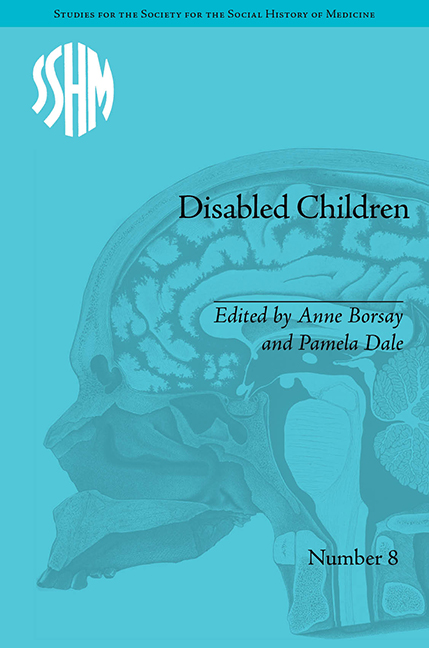Book contents
- Frontmatter
- Contents
- Acknowledgements
- Notes on Contributors
- Introduction: Disabled Children – Contested Caring
- 1 Club Feet and Charity: Children at the House of Charity, Soho, 1848–1914
- 2 Insanity, Family and Community in Late-Victorian Britain
- 3 The Mixed Economy of Welfare and the Care of Sick and Disabled Children in the South Wales Coalfield, c. 1850–1950
- 4 The Question of Oralism and the Experiences of Deaf Children, 1880–1914
- 5 Exploring Patient Experience in an Australian Institution for Children with Learning Disabilities, 1887–1933
- 6 From Representation to Experience: Disability in the British Advice Literature for Parents, 1890–1980
- 7 Treating Children with Non-Pulmonary Tuberculosis in Sweden: Apelviken, c. 1900–30
- 8 Health Visiting and Disability Issues in England before 1948
- 9 Spanish Health Services and Polio Epidemics in the Twentieth Century: The ‘Discovery’ of a New Group of Disabled People, 1920–70
- 10 Cured by Kindness? Child Guidance Services during the Second World War
- 11 Education, Training and Social Competence: Special Education in Glasgow since 1945
- 12 Hyperactivity and American History, 1957–Present: Challenges to and Opportunities for Understanding
- Notes
- Index
5 - Exploring Patient Experience in an Australian Institution for Children with Learning Disabilities, 1887–1933
- Frontmatter
- Contents
- Acknowledgements
- Notes on Contributors
- Introduction: Disabled Children – Contested Caring
- 1 Club Feet and Charity: Children at the House of Charity, Soho, 1848–1914
- 2 Insanity, Family and Community in Late-Victorian Britain
- 3 The Mixed Economy of Welfare and the Care of Sick and Disabled Children in the South Wales Coalfield, c. 1850–1950
- 4 The Question of Oralism and the Experiences of Deaf Children, 1880–1914
- 5 Exploring Patient Experience in an Australian Institution for Children with Learning Disabilities, 1887–1933
- 6 From Representation to Experience: Disability in the British Advice Literature for Parents, 1890–1980
- 7 Treating Children with Non-Pulmonary Tuberculosis in Sweden: Apelviken, c. 1900–30
- 8 Health Visiting and Disability Issues in England before 1948
- 9 Spanish Health Services and Polio Epidemics in the Twentieth Century: The ‘Discovery’ of a New Group of Disabled People, 1920–70
- 10 Cured by Kindness? Child Guidance Services during the Second World War
- 11 Education, Training and Social Competence: Special Education in Glasgow since 1945
- 12 Hyperactivity and American History, 1957–Present: Challenges to and Opportunities for Understanding
- Notes
- Index
Summary
Introduction
In January 1887, the Argus newspaper reported that the government in Victoria, Australia had initiated a scheme ‘to give to the imbecile children of the colony that regular elementary education which is imparted with a gratifying measure of success in England and other countries’. While the want of suitable accommodation had previously presented an obstacle to any such scheme now, the newspaper informed its readers, the government was having four cottages and a schoolhouse constructed in the grounds of the state ‘lunatic’ asylum in the Melbourne suburb of Kew. The report concluded with the hope that ‘as beneficial results will be obtained here as are secured by similar means in England’. When the new institution opened four months later, it was the first purpose-built institution for children with learning disabilities in Australia. Initially known as the Kew Idiot Asylum and later as the Children's Cottages, it remained for the next five decades the most significant state response to the care of children with learning disabilities in Victoria. In this chapter, our focus is on uncovering something of the experiences and feelings of those who lived in the Cottages during this time. This, however, is no easy task.
As other historians have observed, people with learning disabilities have been among ‘the most silent, or voiceless of all historical groups’.
- Type
- Chapter
- Information
- Disabled ChildrenContested Caring, 1850–1979, pp. 73 - 86Publisher: Pickering & ChattoFirst published in: 2014



